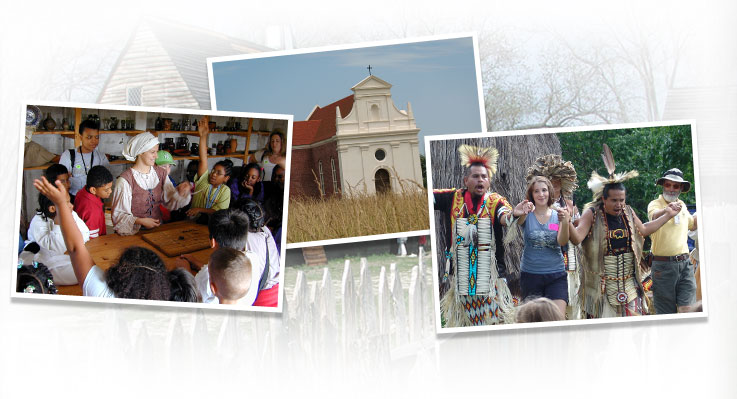Daily Highlights at the Living History Museum
Each site’s activities are varied throughout the year. Below are some of the programs you might encounter.
At the Godiah Spray Plantation
What’s Cooking At The Plantation?
How would you prepare your food and drink without a refrigerator, stove, or microwave? Meet a member of the plantation household and learn how food was prepared over 300 years ago.
Make Ready and Fire
Everyone must know how to fire a musket in 17th-century Maryland. Join a member of the plantation household, as you learn about the whole lock, stock, and barrel.
Rules to Profit By
How do you become a prosperous colonist in 17th-century Maryland? Meet a member of the plantation household and find out how to become rich, or at least, die trying.
Airing Dirty Laundry: A Wagging of Tongues
Come chat with members of the Plantation household, as they show how expertly they can clean their clothes and – at the same time – share their “dirty laundry” with anyone who is interested. Both lye and lies are involved.
Legends, Lore, and a Little Hocus Pocus
Magic, witchcraft, or just good science? Visit the Spray household and learn how they deal with death and illness during the harvest season.
In Town Center
Pressing Matters
Discover what friskets, coffins, carriages, garters, gallows, and the devil’s tail have to do with printing and St. Mary’s City. You might be impressed.
Sports and Leisure
The colonists worked long and hard hours, but every now and then, they had the time for fun. Come experience the games of our ancestors. From bowling to board games, they are anything but boring.
Do You Have Time To Quill?
Writing was a rare skill in 17th-century Maryland. Come experience what only a select few knew how to do. See how to create a quill pen, so that you can write in a colonial manner.
An Ordinary Garden . . . or is it?
How did the colonists survive without modern medical knowledge and medicines? Come to the Smith’s Ordinary garden and discover what the colonists did and if their ideas were really so different from ours.
On the Maryland Dove
What Not To Do When Pirates Attack
In case of attack by pirates, follow these rules:
#1 Whatever you do…don’t make them angry
#2 Refer to rule #1
Come down to the ship and learn what the cannons are
really used for and why the cannons are called murtherers.
Don’t forget to cover your ears!
At the Wooded Indian Hamlet
Fur Factor
Witness and learn about the construction methods and materials – including brains – utilized by the Woodland Indians to create clothing from creatures.
Tying It All Together
How did the Yaocomaco people get their string, without stores to browse, or the Internet to search? Come to the Hamlet and learn how to make cordage like the Woodland Indians did.
From the Ground Up: Extreme Shelter Makeover
How did the natives build and repair their houses and shelters? Witness and learn about the construction methods and materials utilized by the first occupants of this land. Maybe you can lend a hand.
St. John’s Site Museum
Explore Archaeology
Discover how archaeologists and historians pieced together bits of the past to reveal St. John’s legacy of liberty. View some of the 1 million artifacts excavated from the site, and learn what they tell us about the people who once passed through St. John’s doors.
Brick Chapel
Built on the foundation of the original structure, the Chapel commemorates the founding of Catholicism in British North America and early efforts to promote religious toleration. Please visit the pavilion for information on the research required to reconstruct the 17th-century Chapel.
State House
Explore the 1934 re-creation, build to commemorate the 300th anniversary of the state’s founding and the first capital of Maryland. A kiosk inside provides an audio introduction to the building’s history.
Mackall Barn
Step inside the oldest standing wooden barn in Maryland and learn about Maryland’s agricultural heritage.






